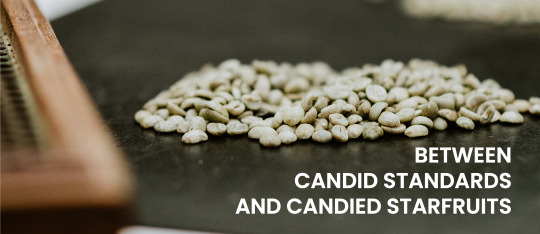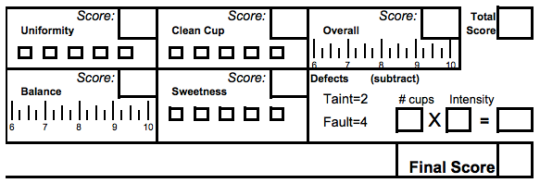This is the first of a three-part series on how evaluating the taste of coffee works. In this weeks post, we explain why it is necessary to have clear standards in a coffee evaluation and we’ll look at the most well-known standards that exist - The SCA form and the Cup of Excellence Scoresheet.
In next week’s post, we will address the “Big 3” - the most important quality aspects to understand the essence of every sensory evaluation of coffee.
Last but not least: Our thoughts on describing coffee with words. From sweet aroma to starfruit acidity - we will have a close look at some common mistakes and propose the idea of a concise coffee grammar.

When we get to taste coffee of outstanding quality it can get pretty crazy sometimes. Coffee people talk about their experience eloquently - full of creativity and excitement. Flavor descriptors range from candied lemon zest to wildflower honey and poached mirabelles.
We describe coffee as being sophisticated. The acidity is citric, malic and phosphoric all at the same time and then the mouthfeel reminds you of that lemonade you had when you were twelve.
While at the moment one may indeed be able to have these associations, the actual liability of such lavish assessment is questionable. Are you sure that you can taste the difference between a lemon and lemon zest? How does malic acid differ from citric and what do you mean exactly when you say the coffee is balanced?
In our industry we ultimately sell taste. Our value proposition is deliciousness. But it also means that we have to take responsibility for the description of our products and that puts up the challenge to describe the characteristics of a coffee without being either too trivial or overpromising.
As a roaster or barista, how many coffees have you already tasted and found remarkable flavors in but then next week it changed completely? None of that sparkling raspberry candy. Where did it go?
One thing is clear. The raspberries were there. It was not an illusion. The problem is that coffee undergoes a complex sequence of processing steps with each of them having an impact on the final cup. The sparkling raspberry candy might have been a combination of genuine red fruit aromatics in the coffee and the level of acidity in the cup. The level of extraction, the roast degree or the alkalinity of the water are all significant for that level of perceived acidity. Maybe not a major change to one of them but the interplay with minute changes to each can sometimes have the same effect as if you went upside down with your roast profile.
The more complex a coffee is, the less tangible its profile becomes.
Why is this relevant to us at algrano?
Algrano is a hub for both exceptional and high standard quality coffee. For the latter category, the quality control is already sufficiently done with a physical analysis (measuring moisture, defect count, screen size, etc.) and a check of the cup consistency and cleanliness.
For what is considered specialty though, the grading involves much more analyses of what is in the cup. Of course, we do all the physical checks as well but this matches the expectations in almost every case.
When it comes to cupping coffees in depth, though, the goal is not to identify every nuance. This might feel counterintuitive at times and require a certain degree of restraint at the cupping table.
The objective of an importer is to find the cup profile that is the largest common denominator between the origin, our office, and your roastery.
To source the raspberry candy coffee for you we first have to make sure that everyone in the supply chain talks about the same coffee. It means, for example, to calibrate brewing and water qualities, consider roasting or the effects of resting of coffee during transport.
Only then we are able to communicate cup quality along the supply chain with a language that is both accurate and standardized. But what does that standard look like?
Faith in the form
With the discovery of specialty coffee, the need for consistent cup evaluation was quickly recognized. In the first place, our industry needed a way to separate specialty from the so-called commodity coffees. This development took place about 15 years ago when the q-grading program was introduced by the Coffee Quality Institute
The SCA protocols are the result of the same efforts at this time and only one year (2004) after the launch of the q-program, the Specialty coffee Association published The coffee cupper’s handbook. Both programs have the same theoretical background.
Generally speaking, it is a system for scoring coffee on a scale up to 100 points by adding up a series of individual scores for major quality aspects such as acidity or flavor. The scores shall be complemented by a literal description of the coffee such as flavor notes or remarks on the balance.
Regardless of the individual aspects of this score sheet, what got stuck with everyone, and what has become a standard in our industry is the final score of a coffee. If I told you we have some 90 point scoring coffees available, you wouldn’t hesitate to order some samples.
Scores have become synonyms for quality and therefore the value of a coffee.
But there are multiple ways to achieve this final rating as a number of score sheets has been introduced over time. Another very relevant one for coffee tasting is the Cup of Excellence form. CoE is a competition for finding the best coffees of a producing country, followed by an auction of the top 21 coffees. Hence the form has been developed for the purpose of analyzing specialty coffee much more accurately, whereas the SCA form was originally developed to separate specialty from non-specialty grade coffee and to add a rating of the “specialness” to the score. Let’s go a bit more into detail.
The difference becomes clear especially when looking at the right side of the SCA scoresheet.

The categories Uniformity, Clean Cup and Sweetness are the basics in every coffee - regardless of it being commodity or specialty grade. A coffee must have at least some level of sweetness. It has to be consistent (uniform) in how it tastes. Otherwise, you simply wouldn’t know what to do with this coffee. The absence of unclean flavors is self-explaining. What is also important to note is that these attributes are rated only on a yes-or-no base. Over five cupping bowls, how many are clean (uniform, sweet)?
Now let’s have a look at the CoE sheet as a rating system that zooms much further into the coffee as it is already assured that the coffee is uniform, sweet and relatively clean.

All categories in this system ask the question: How good is the attribute? It is not enough to say whether or not a certain attribute is present in the cup. It goes deeper into the analyses of how clean or how sweet a coffee is. In addition to that, the chronology of the attributes varies slightly from the SCA form. The classic SCA form argues that aromas and flavors are most elevated at high temperatures. Thus, these attributes must be scores in the beginning. For the aroma itself, this is true of course, as we build the score from the dry fragrance, the smell of the crust and when it is wet. In distinct specialty, flavor and aftertaste tend to change a lot while cooling. It is rather difficult to get the full flavor spectrum within the first rounds of slurping.
The Cup of Excellence sheet pays a contribution to this fact and therefore puts flavor and aftertaste further towards the end of the sheet.
According to this sheet, what should be looked at first is possible defects and the cleanliness of the cup in general, which makes a whole lot of sense. Before analyzing the positive aspects of a coffee, one must confront what is possibly blocking the view. This can be anything from pungent phenolic notes (not in Cup of Excellence of course, but generally speaking) to hints of woody, papery tones.
But enough of the fussy details! Because despite all the differences in the coffee score sheets throughout the world, there are some common truths of what really matters in a cup of coffee. We call them “The Big 3”. Wrapping your head around these core values will give you a profound base for cupping with literally any scoresheet!
In the next blog post, we will go deeper into the rabbit hole of coffee tasting and explain these essentials of the coffee profile.
Meanwhile, what is your biggest hassle when cupping coffee? Let us know in the comments below.




Let Us Know What You Thought about this Post.
Put your Comment Below.